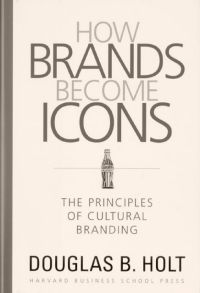|
How Brands Become Icons - The Principles of Cultural Branding
Douglas B. Holt (Oktober 2004)
 "Names, logos, and designs are the material markers of the
"Names, logos, and designs are the material markers of the
brand. Because the product does not yet have a history, how-
ever, these markers are empty. They are devoid of meaning.
Now, think of famous brands. They have markers, also: a
name (McDonald's, IBM), a logo (the Nike swoosh, the Tra-
velers umbrella), a distinctive product design feature (Harley's
engine sound), or any other design element that is uniquely
associated with the product. The difference is that these
markers have been filled with customer experience." (S. 3)
"A brand emerges as various "authors" tell stories that involve
the brand."
(S. 3)
"A brand emerges when .. collective understandings become
firmly established. [...] What makes a brand powerful is the
collective nature of these perceptions." (S. 3)
"Customers value some products as much for what they
symbolize as for what they do." (S. 3)
"Managers typically view identity value superficially as badging,
that is, the idea that consumers use brands as
status symbols
to earn the admiration of their peers." (S. 4)
"Brands become iconic when they perform identity myths: simple
fictions that address cultural anxieties from afar,
from imaginary
worlds rather than from worlds that consumers regularly encounter
in their erveryday life." (S. 8)
"Over time, as the brand performs its myth, the audience eventually perceives that the myth resides in the brand's
markers (e.g., its name, logo, and design elements). The brand becomes a symbol, a material embodiment of the
myth." (S. 9)
"Rather than stewarding the brand to maintain consistency at all costs, ... managers ... better align the brand's myth
with important tensions in .. society." (S. 20)
"The product is simply a conduit through which customers can experience the stories that the brand tells." (S. 36)
"With cultural branding ... the brand's value resides in the specifics of the brand's cultural expression: the particular
cultural contents of the brand's myth and the particular expression of these contents in the communication." (S. 36)
"Brand managers must .. detail the brand's stakes in the transformation of culture and society". (S. 37)
"Brand management is about stewardship: finding the brand's true essence and maintaining this compass point".
(S. 37)
"The brand is a historical entity whose desirability comes from the myths that address the most important social tensions of the nation." (S. 38)
"Identity brands compete in myth markets, not product markets." (S. 39)
"Brands ... provide a material connection to the myth. Because brands load the myth into products used every day,
brands can provide for ritual action". (S. 60)
"Iconic brands leap into emerging myth markets usually led by other mass-cultural products." [...] They develop
a
distinctive point of view and aesthetic as they recycle these cultural materials." (S. 60)
"In cultural branding, the story itself must be the center of strategy, because the quality of the myth ... drives the
brand's identity value." (S. 63)
"Iconic brands ... are cultural innovators that beckon to their audience, suing artistic techniques, to change how
the viewers think and act." (S. 85)
"The economic value of a brand - its brand equity - is based on the future earnings stream the brand is expected
to generate from customers' loyalty, which is revealed in their willingness to pay price premiums compared with
otherwise equivalent products." (S. 95)
"Identity brands perform myths, not mirrors." (S. 126)
"Brand loyalty is the customers' willingness to stay with the brand when competitors come knocking with offerings
that would be considered equally attractive had not the customer and the brand shared a history. The degree of
customer stickiness is key to the brand's market power." (S. 149)
"Iconic brands are usually built with advertisements: films produced by the brand owner. But two other potential
coauthors - cultural industries and populist worlds - can also contribute significantly to the brand's myth." (S. 183)
"Brand communities never exist as ends in themselves. No amount of marketing attention to building a brand
community will compensate for lack of a resonant identity myth
." (S. 184)
"Iconic brands usually borrow from existing myth markets rather than create new myth markets themselves." (S. 214)
"Brand managers must act as composers of the brand's myth. Too often, the job of a brand manager is reduced to
adjective selection -
the management of meaningless abstractions. As culural activists, managers treat their brands
as a medium - no
different than a novel or a film - to deliver provocative creative materials that respond to society's
new cultural
needs." (S. 219)
"Brands become cultural icons by performing myths that address society's most vexing contradictions." (S. 221)
> Zur Buchbesprechung
> Zu unserer Zitatenübersicht
Weitere Informationen über How Brands Become Icons finden Sie
auf 
|